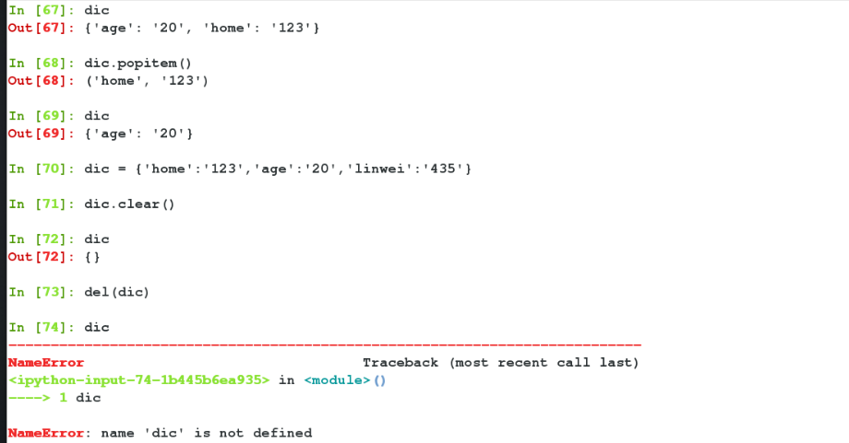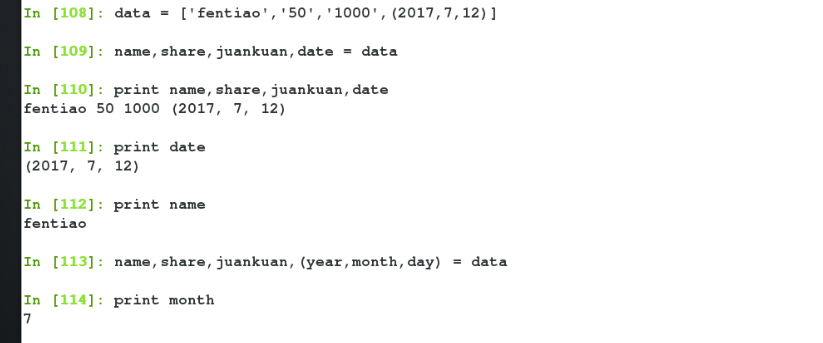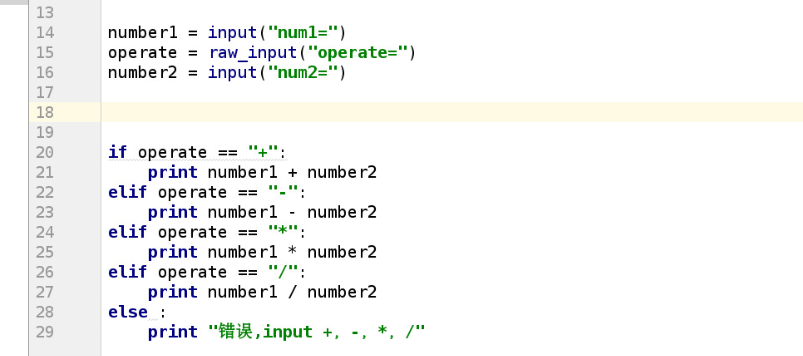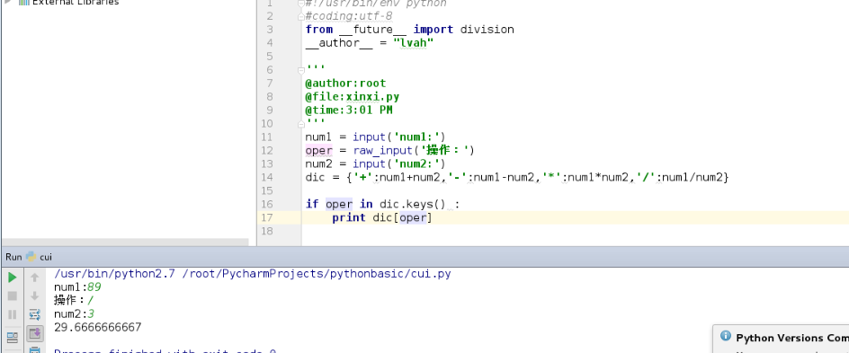python--字典类型
发布时间:2019-07-14 10:23:24编辑:auto阅读(2214)
为什么需要字典类型?
>>> list1 = ["name", "age", "gender"]
>>> list2 = ["fentiao", 5, "male"]
>>> zip(list1, list2)
//通过zip内置函数将两个列表结合,help(zip)
[('name', 'fentiao'), ('age', 5), ('gender', 'male')]>>> list2[0]Out[12]:
//在直接编程时,并不能理解第一个索引表示姓名
'fentiao'
>>> list2[name]
Traceback (most recent call last):
File "<stdin>", line 1, in <module>
TypeError: list indices must be integers, not str
故字典是python中唯一的映射类型,key-value(哈希表),字典对象是可变的,但key必须用不可变对象。字典的定义
简单字典创建>>> dic = {"name":"fentiao", "age":5, "gender":"male"}
>>> dic[0] //不能通过索引提取value值
Traceback (most recent call last):
File "<stdin>", line 1, in <module>
KeyError: 0
>>> dic["name"] //根据key找出value值
'fentiao'内建方法:fromkeys
字典中的key有相同的value值,默认为None
字典值的访问
直接通过key访问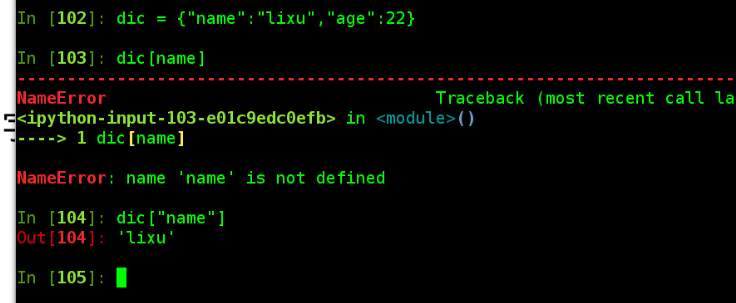
字典key-value的添加
dic[key] = value 通过这个操作,我们会发现字典是无序的数据类型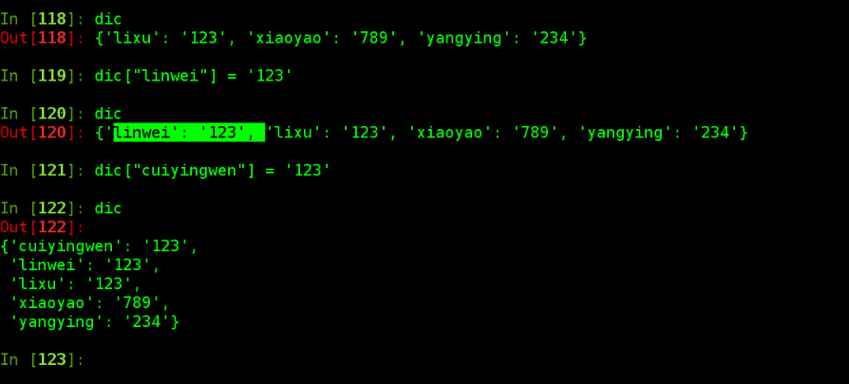
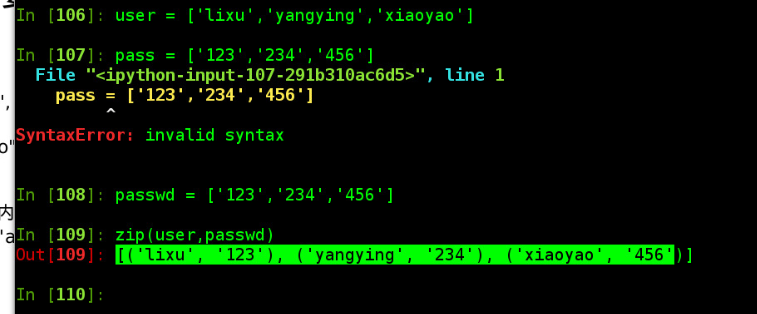
字典的更新
dic.update(dic1)

字典的删除
dic.pop(key) 根据key值删除字典的元素;>>> dic
{'gender': 'male', 'age': 8, 'name': 'fentiao', 'kind': 'cat'}
>>> dic.pop("kind") //弹出字典中key值为"kind"的元素并返回该key的元素
'cat'
>> dic
{'gender': 'male', 'age': 8, 'name': 'fentiao'}
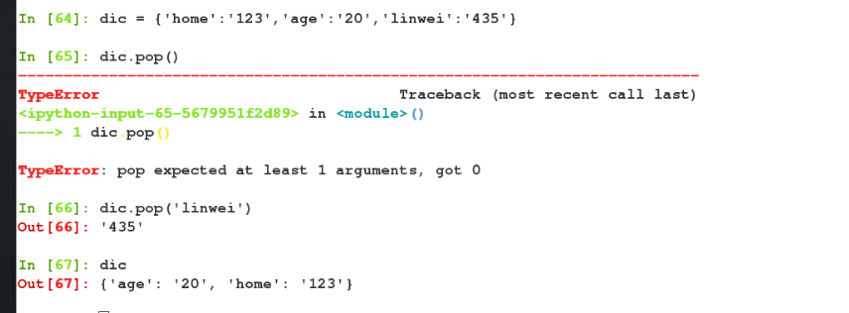
dic.popitem() 随机删除字典元素,返回(key,value)>>>dic.popitem()
('gender', 'male')>>> dic
{'age': 5, 'name': 'fentiao'}
dic.clear() 删除字典中的所有元素>>> dic.clear() //删除字典的所有元素Out[22]:
>>> dic
{}
del dic 删除字典本身>>> del dic //删除整个字典
>>> dic
Traceback (most recent call last):
File "<stdin>", line 1, in <module>
NameError: name 'dic' is not defined字典的常用方法
dict.get() 如果key存在于字典中,返回对应value值>>>dic.get('age')
5
>>>dic.get('gender')
'male'
dic.keys() 返回字典的所有key值>>>dic.keys()
['gender', 'age', 'name']dic.values() 返回字典的所有value值
>>>dic.values()
['male', 5, 'fentiao']dict.has_key() 字典中是否存在某个key值
>>>dic.has_key('name')
True
>>>dic.has_key('age')
True
dic.items()>>>dic.items()
[('gender', 'male'), ('age', 5), ('name', 'fentiao')]

****************** 字典类型 ******************
上一篇: centos 6 升级python 2.
下一篇: Python启动Excel
- openvpn linux客户端使用
51306
- H3C基本命令大全
50756
- openvpn windows客户端使用
41355
- H3C IRF原理及 配置
38163
- Python exit()函数
32636
- openvpn mac客户端使用
29533
- python全系列官方中文文档
28379
- python 获取网卡实时流量
23253
- 1.常用turtle功能函数
23221
- python 获取Linux和Windows硬件信息
21545
- Python搭建一个RAG系统(分片/检索/召回/重排序/生成)
1618°
- Browser-use:智能浏览器自动化(Web-Agent)
2353°
- 使用 LangChain 实现本地 Agent
1956°
- 使用 LangChain 构建本地 RAG 应用
1899°
- 使用LLaMA-Factory微调大模型的function calling能力
2230°
- 复现一个简单Agent系统
1939°
- LLaMA Factory-Lora微调实现声控语音多轮问答对话-1
2629°
- LLaMA Factory微调后的模型合并导出和部署-4
4408°
- LLaMA Factory微调模型的各种参数怎么设置-3
4247°
- LLaMA Factory构建高质量数据集-2
3018°
- 姓名:Run
- 职业:谜
- 邮箱:383697894@qq.com
- 定位:上海 · 松江




